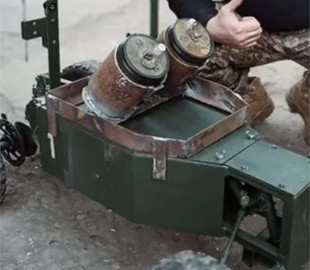
At first, a fragmentation mine OZM-72 was created as a defensive weapon. However, the Ukrainian military created a striking configuration of ammunition using a ground drone.
During the protracted Russian-Ukrainian war, both sides are actively deploying unmanned ground vehicles (UGVs). A notable innovation was the use of OZM-72 anti-personnel mines, originally developed for defensive tasks, by the Ukrainian military in offensive operations. On November 18, the columnists of Army Recognition told more about the original decision of the soldiers of the Armed Forces of Ukraine.
Ukrainian UGVs equipped with launchers for projecting OZM-72 landmines.
The mine is used as a kind of fragmentation mortar shell, exploding on contact.
The fuze mechanism in this questionable use of a powerful and valuable bounding landmine is unclear. https://t.co/v4SV5RWkwV pic.twitter.com/L5kyqBiult— Roy(@GrandpaRoy2) November 13, 2024
The OZM-72 is a Soviet-designed high-explosive fragmentation mine. Once activated, it can rise to a height of almost a meter, where it detonates, scattering fragments over a considerable distance.
The mine gained infamous fame during the Afghan war. In one of the episodes, an accidental explosion of ammunition occurred, which led to the death of four and the injury of 14 soldiers. After that, the army gave it the nickname – “Witch”.
Key characteristics of the weapon:
200% Deposit Bonus up to €3,000 180% First Deposit Bonus up to $20,000- mass – 2.5 kg (warhead – 0.45 kg);
- radius of continuous damage – 25 m;
- height of detonation – 60-80 cm;
- fragments – spherical or plate-shaped, penetrating body armor of the 2nd and 3rd classes.
New role of the OZM-72
Traditionally, this mine is used for defense. Activation occurs with the help of tension cables or pressure mechanisms connected to mechanical detonators of the MUV series (modernized simplified detonator).
However, the Ukrainian military modified these mines, turning them into mobile offensive weapons. With the UGV, the mine is launched as an improvised fragmentation projectile that detonates when it hits the target. This approach makes it possible to use ammunition with high accuracy, minimizing the risk to personnel.
At the same time, in the strike configuration, the mine requires modifications to the standard detonator mechanisms. The fact is that the original detonators, designed to be activated by cable tension or pressure, are not effective enough to reliably trigger during impact. Although the details of the modifications are not disclosed, it is obvious that the adaptation required significant engineering efforts.
Experts note that this innovation demonstrates the ingenuity of the Ukrainian troops in conditions of limited resources. Using UGVs to deliver such ammunition, the Ukrainian army has gained the opportunity to deliver pinpoint strikes on enemy fortifications and equipment, adapting outdated ammunition for modern tactical tasks.
“The use of UGVs in the Russian-Ukrainian conflict has gone beyond traditional functions, such as reconnaissance and logistics. This adaptation not only increases the offensive capabilities of the Ukrainian troops, but also emphasizes the broader trend of integrating advanced technologies to gain tactical advantages on the battlefield,” — the commentators concluded.

